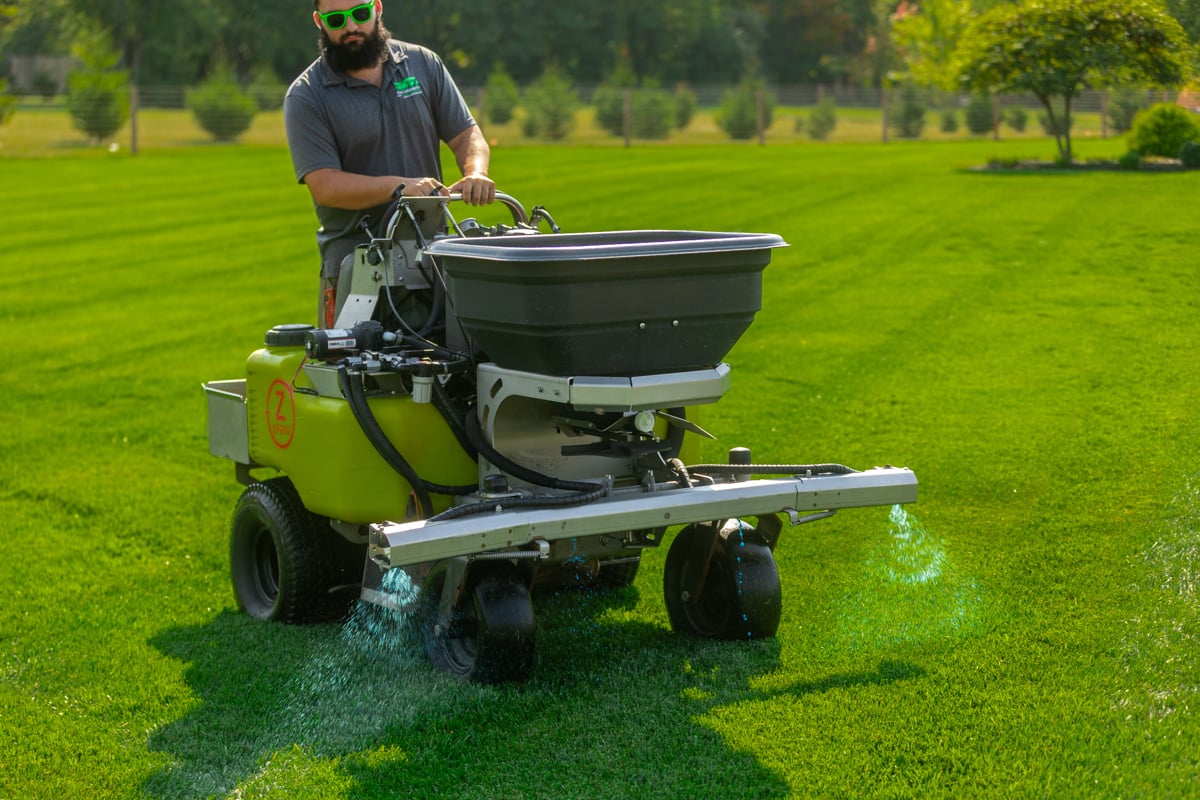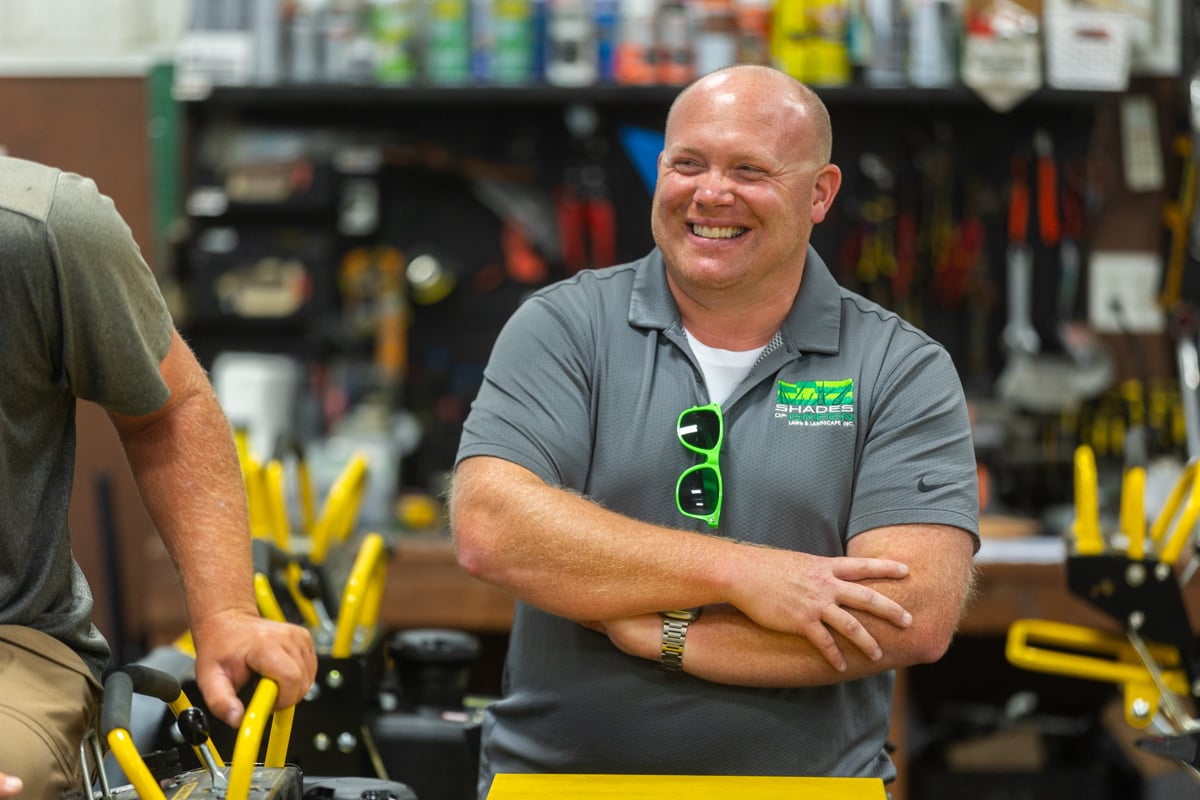
The Best Time to Fertilize Your Lawn in Indiana (And Why it Matters)

If you’ve ever wondered when is the best time to fertilize your lawn, you’re not alone. Keeping up with the “right time” can feel like trying to remember which week to take the trash bin to the corner. Just like your favorite houseplants need regular care, your lawn benefits from a steady diet of nutrients year-round – not just a sprinkle of fertilizer when the grass starts looking hungry. In short, when is the best time to fertilize? The fall months!
In short, when is the best time to fertilize? The fall months!
Let’s break it down season by season so you’ll know exactly when to give your grass the good stuff without stressing over a complex calendar.
Spring Lawn Care
Ah, springtime in Indiana – a season of optimism, unpredictable weather, and the ongoing battle against mud-caked shoes. After months of staring at a dull, yellow lawn, it’s no wonder you are eager to trade in the winter blah for lush green grass ASAP. We get it. But before you go all in with a green-up attack, remember: your lawn doesn’t just need fast care – it needs the right care.
 Spring in Indiana throws your grass a bit of a challenge: warm sun one day, frost warnings the next. Sometimes your lawn needs a quick-release fertilizer to kickstart growth, while other times, slow-release fertilizers are best for providing steady, sustained nourishment. It’s all about watching the weather and listening to what your grass needs.
Spring in Indiana throws your grass a bit of a challenge: warm sun one day, frost warnings the next. Sometimes your lawn needs a quick-release fertilizer to kickstart growth, while other times, slow-release fertilizers are best for providing steady, sustained nourishment. It’s all about watching the weather and listening to what your grass needs.
When is the Best Time to Fertilize in the Spring?
So what is the best Indiana lawn care schedule for the spring months? We follow a three-step schedule to help you conquer spring lawn care:
Application #1 (Early March - Early April): We start by giving your lawn the nutrients it needs to wake up and start growing strong roots after winter’s nap.
Application #2 (Early April - Mid May): This application continues feeding your lawn while keeping weeds in check – because nobody invited them to the party.
Application #3 (May - June): A granular fertilizer application that includes spot weed treatments ensures your lawn stays on track for the summer.
Summer Lawn Care
Summer in Indiana brings the heat, the dryness, and plenty of sweaty afternoons – but here’s a surprise: this isn’t the most intense season for lawn care. While most folks think the real effort kicks in when the thermometer spikes, summer is actually about maintenance and smart planning rather than nonstop work. You don’t (and shouldn’t) push your lawn into overdrive during the summer heat.
Your grass is like a marathon runner – not looking to sprint on a calorie deficit. Giving your lawn the nutrients it needs to thrive without burning out is key to surviving those scorching days.
When is the Best Time to Fertilize in the Summer?
Lawn fertilization services in the summer should have the motto ‘less is more’. Here’s how we tackle the summer season at Shades of Green. As we mentioned above, Application #3 (May -June) is a springtime application that is key for summer lawn health. We put down a carefully custom-formulated, slow-release fertilizer that stays with your lawn throughout the summer. This isn’t some “off-the-shelf” quick-fix fertilizer. We use poly-coated urea (PCU), a fancy way of saying each little granule is protected to release nutrients gradually and precisely over time, even in hot, dry conditions.
As we mentioned above, Application #3 (May -June) is a springtime application that is key for summer lawn health. We put down a carefully custom-formulated, slow-release fertilizer that stays with your lawn throughout the summer. This isn’t some “off-the-shelf” quick-fix fertilizer. We use poly-coated urea (PCU), a fancy way of saying each little granule is protected to release nutrients gradually and precisely over time, even in hot, dry conditions.
So why is this important?
Quick-release fertilizers might sound tempting but aren’t great for summer. They can evaporate (what we in the industry call volatilization) before they even hit the soil, wasting up to 30% of your fertilizer investment.
By contrast, slow-release fertilizers break down gradually, feeding your lawn steadily without risking burnout or wasted nutrients. Think of it as meal prepping for your grass, ensuring it gets consistent, healthy portions rather than a sudden all-you-can-eat-buffet. Remember: quick vs. slow-release fertilizers are NOT about how quickly the fertilizer comes out of the spreader - they are termed this to indicate how quickly the nutrients get to work.
Remember: quick vs. slow-release fertilizers are NOT about how quickly the fertilizer comes out of the spreader - they are termed this to indicate how quickly the nutrients get to work.
Application #4 (July): Our fourth round of fertilization hits the ground in early July. This application focuses on keeping weeds in check with precise spot treatments that target breakthrough troublemakers while keeping your grass healthy and happy.
Fall Lawn Care
Fall lawn care tends to get overlooked. Let’s be honest – once the pool noodles are packed up and the pumpkin spice lattes are flowing, people are not exactly thinking about their grass. But here’s the kicker: fall is the most important season for your lawn. The groundwork (literally) that we lay in these cooler months will set your lawn up for success next spring.
Why? Because your grass is recovering from summer stress and gearing up for winter dormancy. This is prime time to build strong roots and kick weeds to the curb. Think of it as a lawn recovery plan that’ll have your grass feeling fresh and ready to impress next year.
When is the Best Time to Fertilize in the Fall?
Fall isn’t just pumpkin carving season – it’s also when your lawn gets most of its nutrients for the entire year. In fact, 65%-75% of your lawn’s fertilization should happen between September and early December.
Application #5 (September): This quick-release fifth application is like a recovery smoothie after a tough workout. It gives your lawn an immediate boost to help it bounce back from the workout of summer.
Application #6 (October - November): The sixth application tackles weed control. This quick-release fertilizer keeps your grass growing strong and tricks weeds into taking in the weed control material we put down.
Application #7 (November - Early December): This final and seventh application is a heavy hitter. This application is all about setting up your lawn for dormancy and giving it the nutrients to thrive when spring rolls back around.

When to Fertilize a Lawn in Indiana? Watch Out for These Common Fertilization Mistakes
Even with the best intentions, fertilizing your own lawn can go sideways if you’re not careful. Avoid these common mistakes when building your Indiana lawn fertilization schedule.
- Overfertilization: More is not always better. Dumping too much nitrogen, especially early in the season, can stress your lawn and lead to weak, shallow roots. Plus, you risk giving weeds a head start.
- Using the Wrong Product: Quick-release, slow-release – there’s a right time and place for each. Misjudging when and how to apply the proper fertilizer can cause growth spikes, burnout, or wasted nutrients that never even make it to your grass.
- Ignoring Weird Weather: Indiana’s weather has a flair for the dramatic, and sticking to a rigid schedule without adjusting for unexpected heat or dry spells can do more harm than good.
Partnering with Shades of Green for Lawn Fertilization Services
When it comes to lawn care in Lafayette and nearby areas, fertilizing isn’t just a one-and-done task – it’s a year-round investment in your yard’s health and beauty. Fertilizing correctly helps your grass recover from seasonal stresses, builds strong roots, keeps weeds under control, and sets your lawn up for long-term success. But here’s the thing: getting it right can be tricky. Timing, weather, and product choice all matter. That’s where professional care makes a world of difference. At Shades of Green, we customize every fertilizer application to fit your lawn’s needs and Indiana’s ever-changing conditions. No guesswork, no stress – just expert care and a lawn you can be proud of.
But here’s the thing: getting it right can be tricky. Timing, weather, and product choice all matter. That’s where professional care makes a world of difference. At Shades of Green, we customize every fertilizer application to fit your lawn’s needs and Indiana’s ever-changing conditions. No guesswork, no stress – just expert care and a lawn you can be proud of.
Ready to see your lawn thrive like never before? Get started today by filling out our contact form. We provide lawn care services in Lafayette, IN, along with in Carmel, Noblesville, & Westfield.
About Cory Overman

Cory is the heart and soul of Shades of Green. His dedication to doing right for our customers has been the driving force behind the company's success. With a degree in Turf Science from Purdue University, Cory continually strives to craft the best treatment plans using the latest technologies and innovative products, ensuring top-notch results for every client.